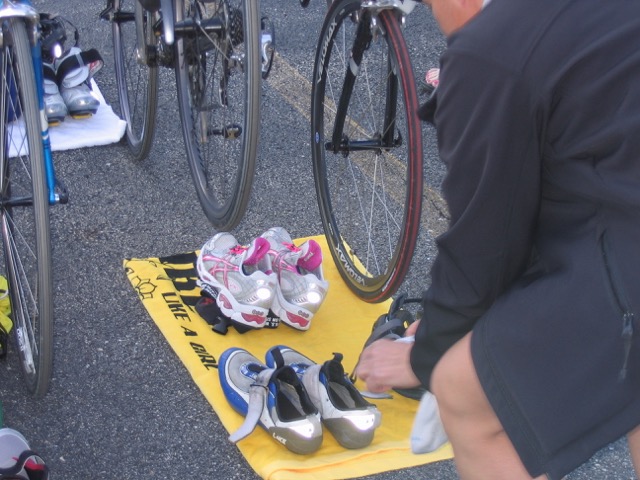Triathlons are a sport based on time. Time in transition still counts! Spending extra seconds on your transitions at race time could cost you a few places in your age group or even the podium. Part of your training needs to be spent on how to shave time off each transition.
After all the endless laps in the pool, hours on the bike and miles of running, if it takes you more than 2 attempts to clip your helmet, or it takes you 3 minutes to tie your shoes, then all that training – shaving seconds or minutes off your swim, bike or run – is totally wasted because of your transition.
There are some tips to ensure that your transitions are as fast and efficient as the rest of your race:
- Apply Anti-Chafe All Over Your Body
This may sound gross, but by rubbing down your body with an anti-chafe product, like BodyGlide, prior to putting on your wetsuit, it will make it easier to get it off. Be sure to apply extra on the ankles, lower legs, arms and neck and these are the frequent problem areas. Ladies may also wish to apply extra anti-chafe to the nape of your neck as your hair can get stuck in the velcro part of your wetsuit when you lift up your head to sight. - Take Your Clothes Off Standing Up
Don’t sit down to take your wet suit off. While you may think it’s easier, it’s a waste of time. Practice taking your wetsuit off while standing up. As you run from the water to transition, unzip the wetsuit, get your arms out and push that wetsuit down to your waist. Once you get to your transition area, work the wetsuit down to your ankles, and then step on the excess to pop one foot out. Then repeat with the other foot. - Use Velcro Shoes
Triathlon-specific cycling shoes will have one or two Velcro straps, you’ll just need to figure out if you need to hold the tongue or slide a finger in the heel. When you set them up in transition, leave the velcro straps open to make it easier to get your feet in them. After a few races, you may be ready to mount and dismount the bike while leaving your shoes on the bike. Word of caution – please practice this over and over until you get it right every time. If you do not have this mastered, do not attempt it in a race. It is dangerous to you as well as the other athletes. - No Socks
There is really no need for socks. Socks are usually worn to help reduce rubbing in your running or cycling shoes, but getting a sock onto a clammy or wet foot will take more time. Instead rub anti-chafing product into your shoes before the race begins. This will help eliminate blisters and will help you be able to slide your foot into your shoes that much easier. - Try Speed Laces
Tying your shoes will take up more time than you have, speed laces are elastic bands that serve as shoelaces and replace the tying process. You simply slide off the biking shoe and slide into your running shoe without the need to sit down and tie your shoe or worrying about then being too tight, too loose, or whether they will come undone mid race!
In regards to each transition specifically – here are some additional tips:
T1: The Swim-Bike Transition
- Do a pre-race walk-through from the swim exit to where your bike will be racked so you know the transition area well and can learn the fastest path.
- Prepare your sunglasses, helmet, and bike shoes so you can access them quickly.
- Decide which side you will approach your bike from, and what direction you will leave with your bike.
- Start planning your approach to the swim exit in the final minutes of the swim. Decide if you’re going to exit right or left to get to the transition area. Stroke as far as you can, then either dolphin dive or run the last bit to shore, then put your goggles on your head to keep your hands free. Then begin peeling off your wetsuit. It should be at your waist by the time you reach T1.
- Once you reach the mount line you don’t have to necessarily mount your bike right away. The area is usually congested and sometimes you have pass several people by running a bit further into the free space where you can then hop on with ease. It is also helpful to run off to the side so as not to impede other athletes who may be quicker than you getting onto the bike.
T2: The Bike-Run Transition
- Figure out where you have to go and know if you have to rack your bike yourself or can you hand it to a volunteer. Get ready by sliding out of your shoes during the final few yards, but don’t ever look down so you don’t run into anyone. Leaving the shoes on the bike should only be done if you have mastered this in practice.
- Dismount your bike and run to your transition spot. Put your helmet down and get into your running shoes. Grab race number, hat, and go. Run the fastest route to exit T2 and proceed onto the run course. Once you’re on your way turn your race number around to the front and put things into the pockets of your race kit.
I hope these tips will help you shave seconds – maybe minutes – off your triathlon times! If you are in need of a triathlon coach to help you with your training, contact me today!







